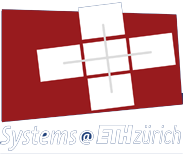Publications by James Dinan
2017
Proceedings of the 25th Annual Symposium on High-Performance Interconnects (HOTI'17), Santa Clara, CA, USA, August 2017
The advent of non-volatile memory (NVM) technologies has added an interesting nuance to the node level memory hierarchy. With modern 100 Gb/s networks, the NVM tier of storage can often be slower than the high performance network in the system; thus, a new challenge arises in the datacenter. Whereas prior efforts have studied the impacts of multiple sources targeting one node (i.e., incast) and have studied multiple flows causing congestion in inter-switch links, it is now possible for a single flow from a single source to overwhelm the bandwidth of a key portion of the memory hierarchy. This can subsequently spread to the switches and lead to congestion trees in a flow-controlled network or excessive packet drops without flow control. In this work we describe protocols which avoid overwhelming the receiver in the case of a source/sink rate mismatch. We design our protocols on top of Portals 4, which enables us to make use of network offload. Our protocol yields up to 4× higher throughput in a 5k node Dragonfly topology for a permutation traffic pattern in which only 1% of all nodes have a memory write-bandwidth limitation of 1/8th of the network bandwidth.
@inproceedings{abc,
abstract = {The advent of non-volatile memory (NVM) technologies has added an interesting nuance to the node level memory hierarchy. With modern 100 Gb/s networks, the NVM tier of storage can often be slower than the high performance network in the system; thus, a new challenge arises in the datacenter. Whereas prior efforts have studied the impacts of multiple sources targeting one node (i.e., incast) and have studied multiple flows causing congestion in inter-switch links, it is now possible for a single flow from a single source to overwhelm the bandwidth of a key portion of the memory hierarchy. This can subsequently spread to the switches and lead to congestion trees in a flow-controlled network or excessive packet drops without flow control. In this work we describe protocols which avoid overwhelming the receiver in the case of a source/sink rate mismatch. We design our protocols on top of Portals 4, which enables us to make use of network offload. Our protocol yields up to 4{\texttimes} higher throughput in a 5k node Dragonfly topology for a permutation traffic pattern in which only 1\% of all nodes have a memory write-bandwidth limitation of 1/8th of the network bandwidth.},
author = {Timo Schneider and James Dinan and Mario Flajslik and Keith D. Underwood and Torsten Hoefler},
booktitle = {Proceedings of the 25th Annual Symposium on High-Performance Interconnects (HOTI{\textquoteright}17)},
title = {Fast Networks and Slow Memories: A Mechanism for Mitigating Bandwidth Mismatches},
venue = {Santa Clara, CA, USA},
year = {2017}
}
2015
TOPC, July 2015
@article{abc,
author = {Torsten Hoefler and James Dinan and Rajeev Thakur and Brian W. Barrett and Pavan Balaji and William Gropp and Keith D. Underwood},
journal = {TOPC},
title = {Remote Memory Access Programming in MPI-3.},
url = {http://doi.acm.org/10.1145/2780584},
year = {2015}
}

